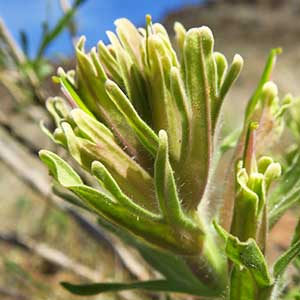Castilleja xanthotricha
Castilleja peirsonii
John Day or yellow-hairy paintbrush, John Day paintbrush, yellow hair paintbrush, yellow-hair Indian paintbrush
Peirson's paintbrush
few to several, ± decumbent to erect or ascending, unbranched, sometimes with short, leafy axillary shoots, hairs erect to spreading, long, soft, eglandular, mixed with short stipitate-glandular ones.
few to several, erect or ascending, unbranched, sometimes branched, hairs dense distally, less so proximally, spreading, long, soft, eglandular, also mixed with short stipitate-glandular ones distally.
green, linear, lanceolate to broadly lanceolate, oblong, or cuneate, 0.8–5 cm, not fleshy, margins plane to wavy, involute, 0–5-lobed, apex acute, sometimes rounded;
lobes spreading, linear, arising below mid length, nearly as broad as center lobe, apex acute.
green to purple, narrowly to broadly lanceolate to oblong, (0.7–)1.5–4.2(–5) cm, not fleshy, margins plane, flat or involute, (0–)3(–5)-lobed, apex acuminate;
lobes ascending-spreading, narrowly lanceolate to linear, apex acute.
3–14 × 1.5–4.5 cm;
bracts proximally greenish, rarely dull reddish purple, distally white to cream, rarely pale yellow or dull, pale pink (sharply differentiated from proximal coloration), lanceolate or oblong to narrowly ovate, (3–)5–7-lobed;
lobes ascending, linear to obovate, ± broadened distally, medium, long, proximal lobes arising below mid length, central lobe apex broadly rounded to truncate, others acute to rounded.
2.5–7.5(–15) × 1.5–3 cm;
bracts proximally greenish to dull reddish, distally bright red, orange, or pale orange, sometimes yellowish or dull red, broadly lanceolate to oblong, 3–5-lobed;
lobes ascending, linear to lanceolate, ± long, arising above mid length, sometimes below mid length on proximal bracts, central lobe apex acute, rarely narrowly obtuse, lateral ones acute.
curved, 17–23 mm;
tube 15–19 mm;
beak exserted, adaxially green, 5–8(–9) mm, puberulent, stipitate-glandular;
abaxial lip deep purple (color sometimes visible through calyx), green, pinkish, or pale yellow, ± prominent, slightly inflated, usually hidden in calyx, sometimes right at top of calyx, 2 mm, ca. 50% as long as beak;
teeth ascending, whitish, yellowish, pink, or green, 1–1.5 mm.
slightly curved, 15–28 mm;
tube 13–15 mm;
beak exserted, adaxially yellow or yellow-green, 7–8 mm;
abaxial lip yellow or deep green, reduced, slightly inflated, pouched, protruding out abaxial cleft, 1–2.5 mm, 13–33% as long as beak;
teeth erect or curved, yellow or green, 0.7–1 mm.
colored as bracts, 15–26 mm;
abaxial and adaxial clefts 3.5–7 mm, 25–50% of calyx length, deeper than laterals, lateral 2–5 mm, 12–25% of calyx length;
lobes linear, oblong, or narrowly triangular, center lobe apex usually rounded, lobes acute to rounded.
proximally light green or yellow, distally yellow or colored as bracts, 12–20 mm;
abaxial and adaxial clefts 5–9 mm, 40–50% of calyx length, deeper than laterals, lateral (1.5–)3–5.8 mm, 10–30% of calyx length;
lobes oblong, apex acute to obtuse.
= 48.
= 24.
Castilleja xanthotricha
Castilleja peirsonii
Castilleja xanthotricha is endemic to moderate elevations in the sagebrush hills of the John Day River drainage in north-central Oregon. N. H. Holmgren (1971) hypothesized that this tetraploid species is of allopolyploid hybrid origin between C. glandulifera and C. oresbia.
(Discussion copyrighted by Flora of North America; reprinted with permission.)
Castilleja peirsonii is endemic to the higher elevations in the Sierra Nevada of California and in Tahoe Meadows in adjacent Washoe County, Nevada. Plants with yellow bracts in the southern portion of the range were named C. carterae. Castilleja peirsonii has shorter, wider corolla beaks than the related C. parviflora. In addition to the corolla shape differences, C. peirsonii also has red to yellow bracts and fairly bright yellow corollas, especially on the beaks, while C. parviflora has purple, pink, or white bracts and greenish corolla tubes and dorsal beak surfaces, with the beak margins pink, purple, or white. Reports from outside the Sierra Nevada in California and immediately adjacent Nevada are misidentifications. Castilleja peirsonii sometimes hybridizes with C. lemmonii in meadows where both species often occur in large numbers.
(Discussion copyrighted by Flora of North America; reprinted with permission.)
